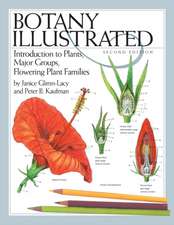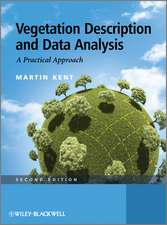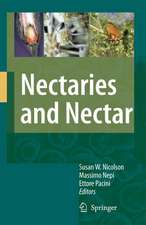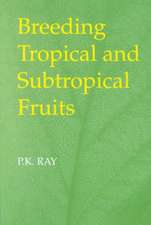Advances in Plant Biopesticides
Editat de Dwijendra Singhen Limba Engleză Hardback – 23 noi 2014
| Toate formatele și edițiile | Preț | Express |
|---|---|---|
| Paperback (1) | 955.25 lei 6-8 săpt. | |
| Springer India – 22 aug 2016 | 955.25 lei 6-8 săpt. | |
| Hardback (1) | 962.66 lei 6-8 săpt. | |
| Springer India – 23 noi 2014 | 962.66 lei 6-8 săpt. |
Preț: 962.66 lei
Preț vechi: 1173.97 lei
-18% Nou
Puncte Express: 1444
Preț estimativ în valută:
184.21€ • 190.04$ • 153.72£
184.21€ • 190.04$ • 153.72£
Carte tipărită la comandă
Livrare economică 27 martie-10 aprilie
Preluare comenzi: 021 569.72.76
Specificații
ISBN-13: 9788132220053
ISBN-10: 8132220056
Pagini: 373
Ilustrații: XV, 401 p. 67 illus., 25 illus. in color.
Dimensiuni: 178 x 254 x 25 mm
Greutate: 0.94 kg
Ediția:2014
Editura: Springer India
Colecția Springer
Locul publicării:New Delhi, India
ISBN-10: 8132220056
Pagini: 373
Ilustrații: XV, 401 p. 67 illus., 25 illus. in color.
Dimensiuni: 178 x 254 x 25 mm
Greutate: 0.94 kg
Ediția:2014
Editura: Springer India
Colecția Springer
Locul publicării:New Delhi, India
Public țintă
ResearchCuprins
1. Different Plant Families as Bioresource for Pesticides.- 2. Natural Insecticides from the Annonaceae – A Unique Example for Developing Biopesticides.- 3. Exploiting Phytochemicals for Developing Sustainable Crop Protection Strategies to Withstand Climate Change: Example from Africa.- 4. Development of Insect Resistance to Plant Biopesticides: An Overview.- 5. Efficacy of Major Plant Extracts/ Molecules on Field Insect Pests.- 6. Botanical Pesticides for the Management of Plant Nematode and Mite Pests.- 7. Plant Disease Management: Prospects of Pesticides of Plant Origin.-8. The Use of Plant Extracts for Stored Product Protection.- 9. Pesticidal Plants for Stored Product Pests on Small Holder farms in Africa.- 10. Non-Target Effects of Botanicals on Beneficial Arthropods with Special Reference to Azadirachta Indica.- 11. Progress in the Development of Plant Biopesticides for the Control of Arthropods of Veterinary Importance.- 12. Role of Plant Biopesticides in Managing Vectors of Communicable Diseases.- 13. Management of Mite Pests in Honeybee Colonies through Botanicals.- 14. Nanotechnology and Plant Biopesticides: An Overview.- 15. Phytochemical Pesticides.- 16. Mode of Action of Plant-Derived Natural Insecticides.- 17. Limitation of Plant Biopesticides.-18. Production and Consumption of Biopesticides.- 19. Formulation, Registration and Quality Regulation of Plant Biopesticides.
Notă biografică
Dr. Dwijendra Singh has served CSIR-CIMAP, Lucknow, in various capacities of research scientist heading the entomology division and reached to the level of Chief Scientist and Head, Crop Protection Division, Microbial Technology and Entomology Department, CSIR-CIMAP, Lucknow. Dr. Dwijendra Singh possesses 39 years of research experience in the field of applied and basic research in the area of entomology.
During his career as scientist, Dr. Dwijendra Singh studied the major pests of medicinal and aromatic plants, phenology of various arthropods associated with mint, wormwood, opium poppy, henbanes and senna. He developed suitable sampling methods for major arthropods of mint species, organic method of white butterfly larvae management by altering sowing time in Cassia angustifolia, identified fennel as allelopathic plant species for mustard aphid management, screened whitefly and begomovirus resistant mint genotypes, investigated the effect of synthetic pesticides on biosynthesis of tropane alkaloids in henbane and menthol in mint as tools for developing integrated pest management. He invented insecticidal principles; himachalol and ß- himachalene from Himalayan cedar wood oil against adzuki bean beetles and houseflies, tylophorine from Indian ipecac leaves as antifeedants against Bihar hairy caterpillar, α-amyrin acetate and oleanolic acid from Catharanthus roseus as insect growth regulators against Helicoverpa armigera, developed cheapest and safe pulse grain protecting phyto-tablet formulation to manage Adzuki bean beetles, demonstrated azadirachtin and its formulations inducing alteration in protein profile of H. armigera larvae which may be utilized to develop novel bio-pesticides. He contributed significantly in development of high yielding pest and disease resistant variety of menthol mint- ‘Himalaya’ that brought revolution in indigenous mint oil production and menthol export. He has explored the possibility of developing novel biopesticides from medicinal and aromatic plant species. He developed the technology on Pulse Grain Protecting Tablet, organic method of pest management in Indian senna and shared in development of agro-technology for new variety of mint – Himalaya.
Dr. Singh’s research findings are evident by his credit to 80 research publications in reputed scientific journals of national and international importance, 2 granted Indian patents and 1 US patent. He has been one of the authors of three books apart from popular book and farm bulletin and has also served as an editorial board member in reputed journals.
During his career as scientist, Dr. Dwijendra Singh studied the major pests of medicinal and aromatic plants, phenology of various arthropods associated with mint, wormwood, opium poppy, henbanes and senna. He developed suitable sampling methods for major arthropods of mint species, organic method of white butterfly larvae management by altering sowing time in Cassia angustifolia, identified fennel as allelopathic plant species for mustard aphid management, screened whitefly and begomovirus resistant mint genotypes, investigated the effect of synthetic pesticides on biosynthesis of tropane alkaloids in henbane and menthol in mint as tools for developing integrated pest management. He invented insecticidal principles; himachalol and ß- himachalene from Himalayan cedar wood oil against adzuki bean beetles and houseflies, tylophorine from Indian ipecac leaves as antifeedants against Bihar hairy caterpillar, α-amyrin acetate and oleanolic acid from Catharanthus roseus as insect growth regulators against Helicoverpa armigera, developed cheapest and safe pulse grain protecting phyto-tablet formulation to manage Adzuki bean beetles, demonstrated azadirachtin and its formulations inducing alteration in protein profile of H. armigera larvae which may be utilized to develop novel bio-pesticides. He contributed significantly in development of high yielding pest and disease resistant variety of menthol mint- ‘Himalaya’ that brought revolution in indigenous mint oil production and menthol export. He has explored the possibility of developing novel biopesticides from medicinal and aromatic plant species. He developed the technology on Pulse Grain Protecting Tablet, organic method of pest management in Indian senna and shared in development of agro-technology for new variety of mint – Himalaya.
Dr. Singh’s research findings are evident by his credit to 80 research publications in reputed scientific journals of national and international importance, 2 granted Indian patents and 1 US patent. He has been one of the authors of three books apart from popular book and farm bulletin and has also served as an editorial board member in reputed journals.
Textul de pe ultima copertă
The ‘Advances in Plant Biopesticides’ comprises 19 chapters on different important issues of developing biopesticides from promising botanicals and its phytomolecules based on the research reviews in the area concern. The book is written by reputed scientists and professors of both developed and developing countries namely Australia, Canada, Czech Republic, Egypt, Greece, India, Kenya, Thailand, Turkey, United Kingdom, and USA represented by almost 53 contributors. The book is organized and presented in such a form that the readers can acquire and enhance their knowledge in plant biopesticide bioresources, its application in different areas to manage pests and diseases of field crops, stored products with status of exploring in Africa, non-target effects on beneficial arthropods, control of arthropods of veterinary and vectors of communicable diseases, efficacy in controlling honeybee mite pests, prospect of applying new tools to enhance the efficacy of plant biopesticides through use of nanotechnology, most important plant derived active principle as source of biopesticides, possible mode of action of phytochemicals against arthropods, limitation, production status, consumption, formulation, registration and quality regulation of plant biopesticides and have been cited by important scientific references. Most importantly, the book also highlights a unique example for developing biopesticides based on the research on Annonaceae as potential source of plant biopesticide, exploiting phytochemicals for developing green technology for sustainable crop protection strategies to withstand climate change with example in Africa, and overview in developing insect resistance to plant biopesticides. Most of the chapter contributing authors are internationally reputed researchers and possess experiences of more than three to four decades in the area of plant biopesticides. The contributing and corresponding authors of the book - Advances in Plant Biopesticides proposed and identified by the editor (Dwijendra Singh) include distinguished professors and reputed scientists from different continents of the world namely MB Isman (Canada), Nadia Z Dimetry (Egypt), Zeaur R Khan (Kenya), John A Pickett (UK), Gadi VP Reddy (USA), S Gopalakrishnan (India), Anand Prakash (India), Chirantan Chattopadyay (India), Christos G Athanassiou (Greece), Philip C. Stevenson (UK), S Raguraman (India), S Ghosh (India), Mir S Mulla (USA), Apiwat Tawatsin (Thailand), Dwijendra Singh (India), K Sahayaraj (India), Suresh Walia (India), T Shivanandappa (India), Roman Pavela (Czeck Republic), Errol Hasan (Australia), Ayhan Gokce (Turkey), SK Raza (India), and their colleague co-contributors. This book would certainly provide the updated knowledge to global readers on plant biopesticides as one of the important reference source and would stimulate to present and future researchers, scientists, student, teachers, entrepreneurs, and government & non-government policy makers interested to develop new & novel environmentally safe plant biopesticides world over.
Caracteristici
The book is based on the research work carried out by eminent researchers across the world-State-of-the-art advances in the field of plant biopesticides have been included
Use of the emerging field nanotechnology in developing plant biopesticides is explained in detail
It is a multidisciplinary research and reference book
The book is timely as it addresses the current issue of importance
Includes supplementary material: sn.pub/extras
Use of the emerging field nanotechnology in developing plant biopesticides is explained in detail
It is a multidisciplinary research and reference book
The book is timely as it addresses the current issue of importance
Includes supplementary material: sn.pub/extras











